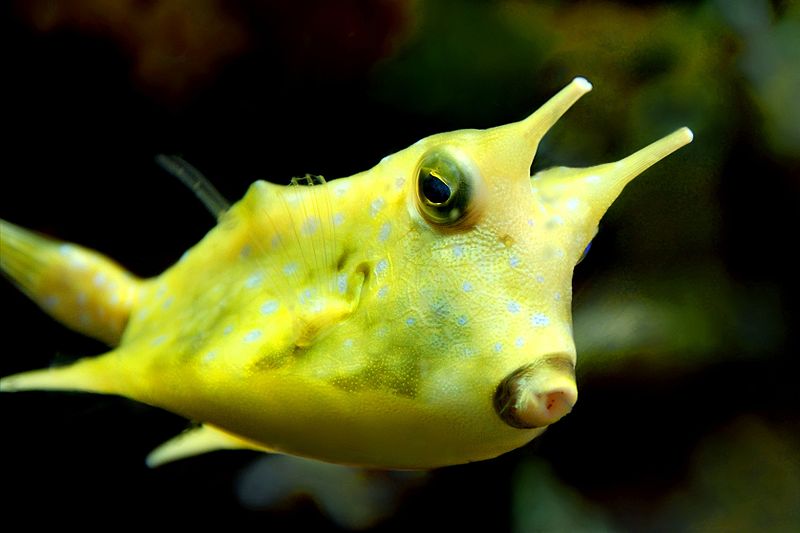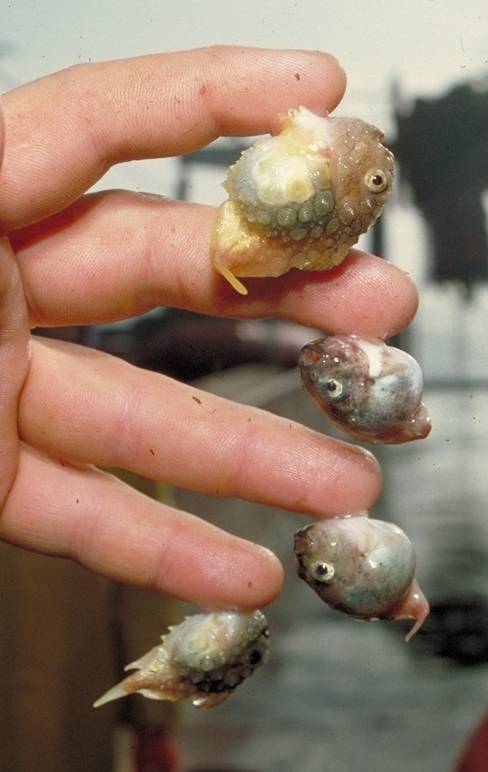But the ocean really is full of amazing and sometimes terrifying creatures. No doubt that a few sightings of some of these beasties contributed to many ancient tales of sea monsters. Here I'll count down the top 15 weirdest bony fish in the ocean. I didn't count in sharks and rays because that's a whole different article. So here we go!
This unique little guy spends his life deep in the
Southern Ocean that surrounds Antarctica where the water often approaches
freezing. Their blood lacks hemoglobin and red blood cells earning them their
clear appearance as seen in the pictures above. They are able to survive
without these oxygen-carrying proteins because the oxygen content of the water
is so high. They also have an antifreeze protein in their blood to prevent the
buildup of ice crystals.
# 14 Mudskippers (Periophthalmus spp)
These fish are amphibians. They move more efficiently on
land than they do in water. They still need water to survive, but using their
powerful pectoral muscles they can "skip" around on land. And they
actually prefer land to water. They can breathe through their skin, but it
needs to be moist to do so. They even lay their eggs on land. These fish can be kept in very specialized home aquariums; the water should be brackish and these fish need an area of land to hop about.
# 13 Ocean Sunfish (Mola mola)
This fish is widely considered the largest bony fish.
They average about 5.9 ft (1.8 m) in length and 2,200 lb (1,000 kg) in weight,
although individuals up to 10.8 ft (3.3 m) in length 14 ft (4.2 m) across the
fins and weighing up to 5,100 lb (2,300 kg) have been observed. It can grow so
large because the fish displays delayed calcification of the bones. Their
caudal fin is distorted into a psuedo-tail called a clavis which gives them
their distinctive shape. They swim using their dorsal and anal fins. These fish
got their name from the tendency to lie on their side near the surface and
allow birds and cleaner wrasse to remove parasites from their skin. While they
may be huge, they eat relatively small jellyfish and are very peaceful fish.
# 12 Longhorn cowfish (Lactoria cornuta)
Don't get out your lasso just yet. This guy is only about
1 foot long. They live in tropical reefs in Indo-Pacific. They are in the same
order as puffer fish and the Ocean Sunfish. They are known to produce a toxin
similar to pufferfish when stressed. This is because they are closely related
to puffers.With the right size setup, this is one of two fish in this article that can be kept in home aquariums.
# 11 Giant Oarfish (Regalecus glesne)
Sometimes known as the "King of Herrings"
although it is not related to herrings. It has the title of being the longest
bony fish in the world with a max reported length of 65ft (17 m). This other-worldly
creature is one that surely spawned a lot of sea monster legends. Just look at
the pictures and you can see why. Live specimens are rarely seen as they spend
a lot of their time at deep depths, which adds to the mystery of the creature.
# 10 Leafy Seadragon (Phycodurus eques)
While it has dragon in the name, this seahorse relative
is nothing like the mythical beasts. It floats along using its fleshy
protrusions to camouflage itself. The leafy seadragon can also change its color
to better camouflage itself. It is one of the most spectacular examples of
camouflage: neither prey nor predators recognize it as a fish. Its long snout
is used to suck up small fish and shrimp.
It's found on reefs with kelp in the south of Australia. Like most seahorses, the father broods the eggs in his pouch. But
unlike most seahorses the tail of the leafy seadragon is not prehensile.
# 9 Pacific Spiny Lumpsucker (Eumicrotremus orbis)
Lumpsucker is a very appropriate name for this little guy
as it looks more like a lump than a fish. Its pelvic fins are modified into an
adhesive disk that allows these strange fish to maintain a firm grip on rocks
because they don't move around a great deal. They catch food as it passes by.
# 8 Spotted Handfish (Brachionichthys hirsutus)
Ever seen a fish with hands? This strange little guy
doesn't have hands, but his modified pectoral fins look really close. This guy
uses his pectorals to "walk" across the ocean floor. They only live
in Australia and are in big trouble due to an introduced starfish that consumes
its eggs. They are only being recorded in the estuary of Derwent River, Tasmania,
and nearby areas. The IUCN lists them as critically endangered.
# 7 Barreleyes (Macropinna microstoma)
Otherwise known as the fish with a glass head, this
strange fish hangs motionless in the waters between 2,000 ft (600 m) to 2,600
ft (800 m), in the depths where almost no light reaches. The top of its head is
filled with a clear liquid. It turns its barrel-shaped eyes skyward and watches
for food to fall. When it sees food, the eyes swivel back into place and it
swims toward its food. Creepy, no?
# 6 Fangtooth (Anoplogaster cornuta)
This tiny terror of the deep has the largest teeth
relative to body size of all the fishes. In adults, the largest two fangs of
the lower jaw are so long that the fangtooths have a pair of opposing sockets
on either side of the brain to accommodate the teeth when the mouth is closed.
Juvenile fangtooth look so different from adults that they were once classified
as a separate species.
# 5 Gulper eel (Eurypharynx pelecanoides)
Another oddity of the deep. This fish is almost all mouth
and can swallow fish much larger than itself with its loosely hinged jaw. At
the end of its whip-like tail are organs that glow presumably to attract prey.
This fish only grows to 3 ft (1 m) so you only have to worry about it gulping
up your dogs and children ;)
# 4 Blobfish (Psychrolutes marcidus)
Dubbed the "most miserable-looking fish" the
blobfish is the result of the high-pressure environment in which it resides.
With pressures being several times that what occurs at normal sea levels
buoyancy via a swim bladder is inefficient. The blobfish remedies this by being
a gelatinous mass with a density slightly less than that of water. It has
almost no muscle mass, but that doesn't both it because it just gulps any edible
matter that floats in front of its face. Unfortunately this sad little blob
could one day become extinct. Because of its inability to swim rapidly it often
gets caught in deepsea trawling nets. It is only known to exist in one area off
the coast of Australia where trawlers fish for crab and lobster. Sadfish is
sad.
# 3 Fanfin Seadevil (Caulophryne jordani)
This is the stuff nightmares are made of. This member of
the anglerfish family rightfully earns the name seadevil. But the fact that it
only grows to 4.3 in (11 cm) takes away a lot of the fright factor. The Fanfin
Seadevil is distinguished from other anglerfish in that it does not rely on
biolumincense to attract prey. Male anglerfish are also a neat thing (ladies,
you'll like this one). Male anglerfish don't grow nearly as large as female
anglerfish. Their sole purpose in life is to seek out the females. Once they do
they latch onto the female and become parasitic. Their bodies whittle away to
nothing but testes with their only purpose being to provide sperm for the
female's eggs. This is because mates are so hard to find in the deep sea, that
once you have one its best to stick with that one until it’s all over.
# 2 Red-lipped Batfish (Ogcocephalus darwini)
This guy gives the blobfish a run for its money as the grumpiest fish in the ocean. Found
only around the Galapagos Islands this strange creature doesn't swim across the
ocean floor; like the handfish, it walks across it using its pectoral fins. In
adulthood the dorsal fin modifies to become the fleshy protrusion in front of
its face. It's used to attract prey and give it the appearance of a nose.
Personally, I think this is the ugliest fish in the ocean. The handfish, batfish,
and seadevil are all types of anglerfish (Order: Lophiiformes) and have many
more creepy cousins. The first minute of the video below shows this strange fish in action.
# 1 Psychedelic frogfish (Histiophryne psychedelica)
No you are not tripping. This is an actual fish. This
recently described fish earns the title of weirdest fish in the ocean not just
for its groovy pattern but its mode of locomotion. While it often walks along
the bottom using its pectoral fins, it can also shoot a jet of water through
its gills and jettison itself. During this motion it takes on a ball shape and
literally bounces along the ocean floor. You can see this in the video below.
The odd shape of its face also gives it depth perception believed to be similar
to that of humans. It's associated with coral reefs and has only been found on
Ambon Island in Indonesia thus far. Don't stare at its eyes too long.















No comments:
Post a Comment
Note: Only a member of this blog may post a comment.